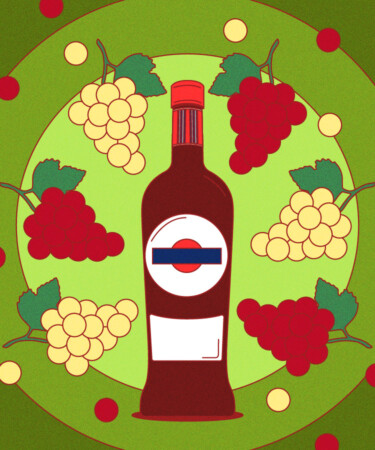These days, vermouth gets more cocktail mileage than ever. Like amaro, it was originally touted for its supposed medicinal benefits before it became a popular aperitif, often served as a standalone sipper with the occasional citrus twist. Then, it got adopted by early cocktail culture in the late 1800s, where it has remained ever since.
Despite its popularity, there are still many misconceptions about vermouth, one of the most common being that it’s some type of amaro or liqueur. That’s because its ABV and conventional usages are more in line with a liqueur than what it actually is: a fortified and aromatized wine. Like sherry or port, vermouth is wine that’s been given an extra bump in the ABV department thanks to the addition of a neutral spirit. In vermouth’s case, it’s generally fortified with brandy, and then flavored with a bounty of herbs, botanicals, and spices. Another surprise: Even the sweetest, most syrupy red vermouth on the shelf is almost exclusively made with white wine grapes.
Red vermouth, or sweet vermouth, actually contains roughly three times the sugar content of its dry counterpart, and that caramelized sugar is actually what gives it its signature rosy color. All the while, it packs more tannins than both dry and white vermouths. While these types of vermouths traditionally hail from France, the red variety was born in Italy. The Muscat grape was the first one to be widely used for making vermouth, as it’s native to the Piedmont region where it grows in abundance. It’s also naturally high in sugar, which means that less sugar needs to be added to the vermouth later on to make it the appropriate level of sweetness.
Dry and white vermouths are made with neutral white grapes as well, but in addition to sugar content, another of their key differences from red vermouth lies in each style’s botanical builds. Dry and white vermouths generally pull from a repertoire of French herbs and botanicals: Wormwood is a heavy contender, as well as verbena and ginger, which both impart floral, herbaceous qualities on the finished product. Red vermouths tend to contain earthier, baking-adjacent spices and herbs like nutmeg, vanilla, cloves, and cinnamon. Consider Carpano Antica as a classic example. It contains a base of Italian grapes from Romagna, Puglia, and Sicily along with a heavy dose of vanilla. Many describe its flavor profile as a bouquet of rich, unctuous flavors like cocoa, toffee, and almonds with a slight bitter base.
All this said, the white-wine-grape-only rule is not cut and dry. There are some red vermouths out there that employ a mix of red and white wine grapes. And in the 21st century, we’ve also seen producers break the molds of traditional production by making red vermouths exclusively with red wine grapes native to their vineyards. There’s Argentina’s La Fuerza that uses only Malbec grapes from Mendoza and herbs from the Andes in its Rojo expression. And then there’s Uruguay’s Vermut Flores, made with red Tannat grapes. This movement isn’t just taking hold in South America, either. New Zealand’s Reid + Reid Red Vermouth is built on a base of 100 percent Pinot Noir, and even in Italy where it all began, there are bottlings like Gran Bassano Rosso, which employs only Merlot, a grape native to France’s Bordeaux region.
In vermouth production, an age of experimentation is upon us, but traditional methods are still alive and well. So the next time you’re eyeing up a shelf of various red vermouths, know that most of them — if not all — are gonna be amped-up, herbaceous, sweetened white wines. Don’t let that candy-red hue fool you.
*Image retrieved from 5ph via stock.adobe.com
